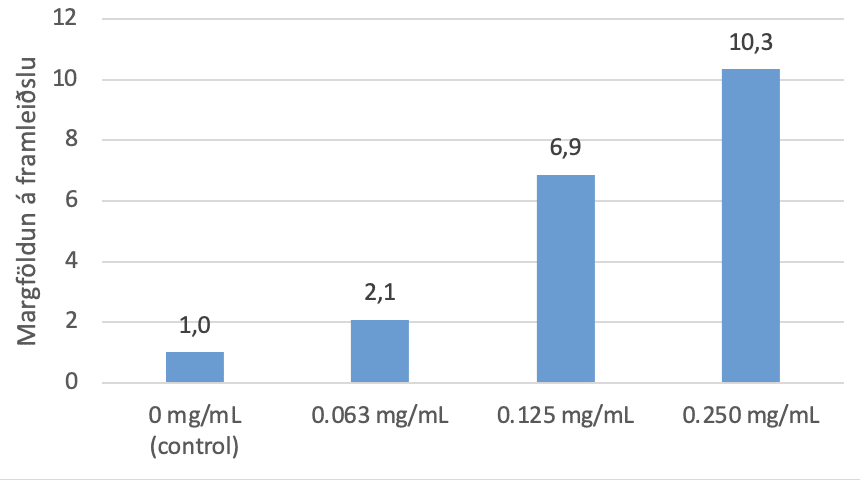The aim of the project Natural skin protection from the sea, which was funded by the AVS funds, was to develop new skin products from Icelandic bubble seaweed (Fucus vesiculosus) which is an underutilized ingredient but extremely rich in antioxidants and protective substances. This report reviews the development history of skin products with bioactive ingredients from bubble seaweed. In addition, the development of processing methods for the isolation of bioactive substances and the bioactivity measurements that were carried out on them are discussed. Many different samples were produced with different extraction methods and the total amount of polyphenols (total polyphenol content, TPC) and their antioxidant activity were studied. Dermal cell tests were performed on supernatants from epidermal cells (Detroit 551), which are healthy skin cells, or on supernatants from fibroblasts (HT1080), which are cancer cells, to measure the activity of extracts from bubble seaweed. Among other things, measurements were made on the ability of seaweed extracts to inhibit metalloprotease 1 and the inhibition of PMN elastase production. Also on the production of collagen (human collagen type 1, HCT-1).
All the results for the measurement of the total amount of polyphenols and for the different antioxidant tests were combined and the extraction method that gave the highest amount of polyphenols and therefore the highest antioxidant activity was selected.
The main results of the skin cell tests showed that the seaweed extracts stimulate the production of collagen. Seaweed extract was applied to the skin cells (Detroit 551) in different concentrations and showed a huge increase (200-1000%) in the production of collagen (see picture). Measurements were made of metalloproteases 1, 2 and 9, which are known to degrade collagen. The highest concentration of seaweed extract (0.25 mg/mL) inhibited metalloprotease 1, but no specific inhibitory effect was measurable for metalloproteases 2 and 9. PMN elastase production was also inhibited at three different concentrations. These results suggest that the seaweed extract may have an anti-wrinkle effect by increasing collagen synthesis and inhibiting elastase.

Production of collagen (human collagen type 1), as a percentage of blank, in D551 skin cells treated with different concentrations of seaweed extract (0.0625 – 0.25 mg/ml).
The report also details the product development of skin care products with bioactive ingredients from seaweed, the consumer trials conducted along with product design, marketing and promotions. In Appendix I there is more information about the consumer research and in Appendix II there is a more detailed report on the product design prepared by the product designer.
___
The goal of the project Natural skin protection from the ocean, funded by the AVS research fund, was to develop new skincare products from Icelandic bladderwrack (Fucus vesiculosus), which is an underutilized raw material but extremely rich in antioxidants and protective compounds. This report outlines the development process of skincare products with bioactive ingredients derived from bladderwrack. Additionally, it discusses the development of processing methods for isolating bioactive compounds and the bioactivity measurements that were conducted on them. Various samples were produced using different extraction methods, and their total polyphenol content (TPC) and antioxidant activity were analyzed.
Skin cell tests were performed on supernatants from skin cells (Detroit 551), which are healthy skin cells, or supernatants from fibroblast cells (HT1080), which are cancer cells, to measure the activity of extracts from bladderwrack. Measurements included the ability of bladderwrack extracts to inhibit matrix metalloproteinase 1 (MMP-1) and the inhibition of PMN elastase production. Also, the production of collagen (human collagen type 1, HCT-1) was assessed.
All the results from the total polyphenol content measurements and the various antioxidant tests were compiled, and the extraction method that yielded the highest polyphenol content, and consequently the highest antioxidant activity, was selected.
The main results from the skin cell tests showed that the bladderwrack extracts stimulated collagen production. The extracts were applied to the skin cells (Detroit 551) at different concentrations and showed a significant increase (200-1000%) in collagen production (see figure). Measurements were done on metalloproteinase 1, 2 and 9 which are known to break down collagen. The highest concentration (0.25 mg/mL) inhibited matrix metalloproteinase 1, but no significant inhibition was observed for matrix metalloproteinase 2 and 9. Additionally, PMN elastase production was inhibited at three different concentrations. These results suggest that the bladderwrack extract may have anti-wrinkle effects by increasing collagen production and inhibiting elastase.

